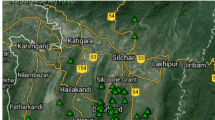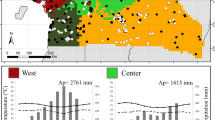Abstract
Bamboos are widely distributed in mainland Southeast Asia and have abundant biomass. They are characterized by prolonged vegetative growth and semelparity. Where bamboos are dominant, their synchronous flowering and death has a major impact on forest vegetation. Although the small-scale dynamics of this process have become clearer in recent years, the history, geographical scale and synchronicity of bamboo flowering over broad areas remains unknown. This study focused on the flowering history of six bamboo species, Bambusa tulda, Cephalostachyum virgatum, Dendrocalamus hamiltonii, Dendrocalamus membranaceus, Indosasa sinica and Oxytenanthera parvifolia, over 40 years across a broad area of northern Laos. We also examined the synchronicity of flowering in D. membranaceus. We visited 49 villages in northern Laos and surveyed knowledgeable inhabitants about bamboo flowering history. The timing, scale and synchronicity of gregarious flowering varied among species. D. hamiltonii and D. membranaceus showed higher flowering synchronicity than other species. All the species except I. sinica had both sporadic and gregarious flowering traits, and showed conspicuous variability in their flowering scale. The flowering bamboo population at two gregarious flowering sites for D. membranaceus was surveyed. While this species had the highest synchronicity in this study, its synchronicity was lower than other species in previous studies worldwide. We found that the gregarious flowering of bamboos in northern Laos over the last 40 years showed lower synchronicity than bamboo flowering reported in other areas of the world. The historical dynamics and scale of bamboo flowering must be further clarified to understand the vegetation composition of this area.
Similar content being viewed by others
References
Abe Y, Shibata S (2012) Spatial and temporal flowering patterns of the monocarpic dwarf bamboo Sasa veitchii var. hirsuta. Ecological Research 27: 625–632. DOI: 10.1007/s11284-012-0933-9
Clark LG (1997) Bamboos: the centerpiece of the grass family. In: Chapman GP (ed.), The Bamboos. Academic Press, London, UK. pp 237–248.
Condominas G (1957) We have eaten the forest: the story of a Montagnard village in the central highlands of Vietnam (Nous avons mange la foret). Mercure de France. p 668. (In Japanese)
Dransfield S, Widjaja EA (1995) Plant Resources of South-East Asia 7: Bamboos. Backhuys Publishers, Leiden. Netherland. p 189.
Filgueiras TS, Pereira BAS (1988) On the flowering of Actinocladum verticillatum (Gramineae: Bambusoideae). Biotropica 20: 164–166. DOI: 10.2307/2388190
Franklin DC (2004) Synchrony and asynchrony: observations and hypotheses for the flowering wave in a long-lived semelparous bamboo. Journal of Biogeography 31: 773–786. DOI: 10.1111/j.1365-2699.2003.01057.x
Gadgil M, Prasad SN (1984) Ecological determinants of life history evolution of two Indian bamboo species. Biotropica 16(3):161–172. DOI: 10.2307/2388050
Giordano CV, Sanchez RA, Austin AT (2009) Gregarious bamboo flowering opens a window of opportunity for regeneration in a temperate forest of Patagonia. New Phytologist 181(4): 880–889. DOI: 10.1111/j.1469-8137.2008. 02708.x
Isagi Y, Oda T, Fukushima K, et al. (2016) Predominance of a single clone of the most widely distributed bamboo species Phyllostachys edulis in East Asia. Journal of Plant Research 129(1): 21–27. DOI: 10.1007/s10265-015-0766-z
Janzen DH (1976) Why bamboos wait so long to flower. Annual Review of Ecology and Systematics 7: 347–391. DOI: 10.1146/annurev.es.07.110176.002023
Kanemaru K, Muhammad R, Hirota I (2014) Analysis of monsoon climate variability for swidden agriculture in northern Laos. In: Yokoyama S, et al. (eds.), Integrated Studies of Social and Natural Environmental Transition in Laos. Tokyo, Japan. pp 85–97. DOI: 10.1007/978-4-431-54956-7_5
Lindell K, Lundstrom H, Svantesson J, et al. (1982) The Kammu Year. Scandinavian Institute of Asian Studies, Copenhagen, Denmark. p 191.
Makita A (1996) The significance of the model of clonal growth in the life history of bamboos. Plant Species Biology 13: 85–92. DOI: 10.1111/j.1442-1984.1998.tb00251.x
Makita A, Suzuki J, Suyama Y (2010) The bamboos-their mysterious life histories. Japanese Journal of Ecology 60(1): 45–50. (In Japanese)
Marchesini VA, Sala OE, Austin AT (2009) Ecological consequences of a massive flowering event of bamboo (Chusquea culeou) in a temperate forest of Patagonia, Argentina. Journal of Vegetation Science 20: 424–432. DOI: 10.1111/j.1654-1103.2009.05768.x
Ministry of Agriculture and Forestry (1997) A manual of the bamboos of the Lao PDR. Ministry of Agriculture and Forestry, Vientiane, Laos. p 108.
Ministry of Agriculture and Forestry (2003) Agricultural statistics yearbook 2003. Ministry of Agriculture and Forestry, Vientiane, Laos. p 144.
Nakashizuka T (1988) Regeneration of beech (Fagus crenata) after the simultaneous death of undergrowing dwarf bamboo (Sasa kurilensis). Ecological Research 3: 21–35. DOI: 10.1007/BF02348692
Numata M (1970) Conservation implications of bamboo flowering and death in Japan. Biological Conservation 2(3):227–229. DOI: 10.1016/0006-3207(70)90120-5
Shibata S (2010) Examination into records and periodicity concerning to Melocanna baccifera flowering with 48-year interval. Japanese Journal of Ecology 60: 51–62. (In Japanese)
Suyama Y, Suzuki J, Makita A (2010) For the comprehension of gregarious flowering in bamboos. Japanese Journal of Ecology 60(1): 97–106. (In Japanese)
Tanaka H, Marod D, Ishida A, et al. (2010) Regeneration of cooccurring tropical bamboos after the simultaneous flowering and death: a bamboo species formed "sapling bank" under the shade of the other species. Japanese Journal of Ecology 60(1): 63–72. (In Japanese)
Taylor AH, Reid DG, Qin Z, et al. (1991) Spatial patterns and environmental associates of bamboo (Bashania fangiana Yi) after mass-flowering in southwestern China. Bulletin of the Torrey Botanical Club 118: 247–254
Taylor AH, Qin Z (1988) Regeneration from seed of Sinarundinaria fangiana, a bamboo, in the Wolong giant panda reserve, Sichuan, China. American Journal of Botany 75: 1065–1073. DOI: 10.2307/2443774
Widmer Y (1998) Flowering phenology of Chusquea bamboos with special reference to Chusquea talamancensis in Costa Rica. Journal of American Bamboo Society 12: 1–20.
Xie N, Chen LN, Wong KM, et al. (2016) Seed set and natural regeneration of Dendrocalamus membranaceus Munro after mass and sporadic flowering Yunnan, China. PLoS ONE 11(4): e0153845. DOI: 10.1371/journal.pone.0153845
Acknowledgments
This work was supported by JSPS KAKENHI(Grant Number 22241012).
Author information
Authors and Affiliations
Corresponding author
Additional information
http://orcid.org/0000-0003-3138-3027
Rights and permissions
About this article
Cite this article
Hirota, I. Local records of long-term dynamics of bamboo gregarious flowering in northern Laos and regional synchronicity of Dendrocalamus membranaceus in two flowering sites. J. Mt. Sci. 14, 1058–1064 (2017). https://doi.org/10.1007/s11629-016-3990-7
Received:
Revised:
Accepted:
Published:
Issue Date:
DOI: https://doi.org/10.1007/s11629-016-3990-7




